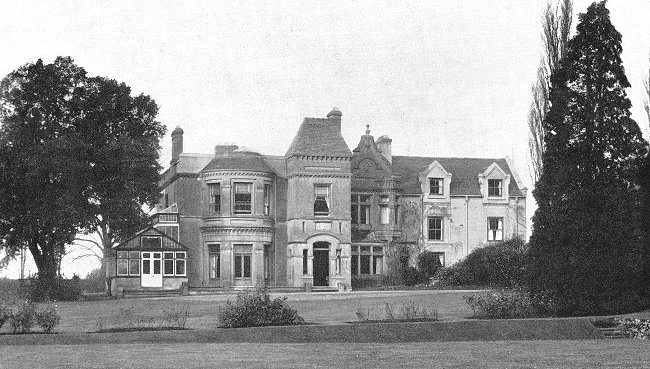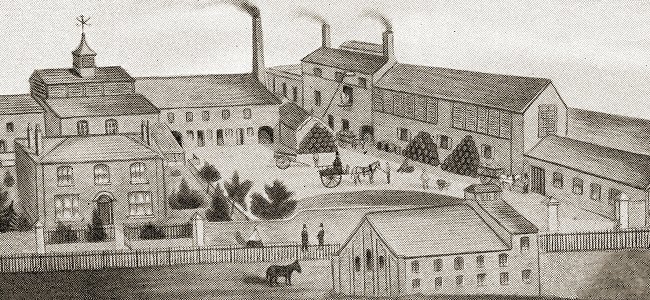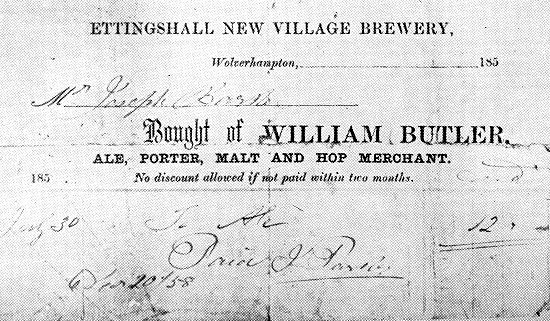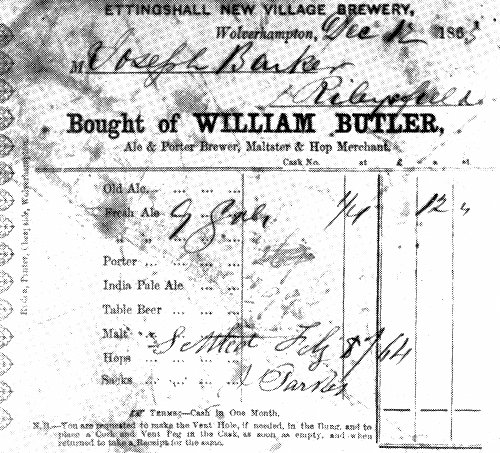|
Early Growth Orders continued to grow, and so in
1864 Mr. G. T. Lawley was engaged as a clerk to assist Mark
Taylor. Twelve months later he became the brewery’s second
traveller and agent, in order to reduce George Parkes’ workload. His
role in the office was taken over by a younger man. By this
time William’s family had grown, and so he left the house by
the brewery and moved into a larger and more palatial house
called ‘The Bhylls’ in Bhylls Lane, Castlecroft. When the
Butler family left their old home, the two ground floor
front rooms became the office, and Mark Taylor resided at
the back. |

The Bhylls, later called Bellencroft.
| Life at the Bhylls was much grander
than at Priestfield. The house had several large ground
floor rooms including a morning room, drawing room, dining
room, an ante room, and a conservatory. Other rooms included
a large kitchen, a larder, dairy, pantry, china
pantry, and a scullery. There were eight bedrooms on the
first floor, a dressing room, a bathroom, toilets, and two
servant’s bedrooms above. The house also had a
wine cellar, a stable in the yard, an extensive kitchen
garden, a flower garden, and tennis courts; everything that
you could expect to find in a successful gentleman’s country
residence. |
 |
A nice image of Ettingshall New
Village
Brewery from 1867, presumably produced for advertising
purposes Butler's Magazine,
May 1924. |
|
In 1871 the Butler family moved again,
to a new and even larger house, which William had built. The
house, called ‘The Cedars’ on Compton Road is still there
today. The family’s improved lifestyle was a direct result
of the success of the brewery which went from strength to
strength. The twenty two staff in 1871 were as
follows:
|
Brewery |
Thomas Salt and his assistant
J. Corfield. |
| Tun
Room |
J. Sutton and W. Roberts. |
|
Cellars |
J. Faux and T. Sutton. |
|
Cooperage |
G. Dytch who replaced R.
Allman who died that year. |
|
Cask Washing |
S. Jackson and an
assistant. |
|
Maltings |
J. Vernon and an assistant:
J. Vernon replaced R. Boden who died that year. |
|
Engineer |
J. Johnson. |
|
Blacksmith |
J. E. Jarvis. |
|
Bottler |
J. Grove. |
|
Draymen |
W. Willis, J. Panting, W. Tysoe, and A. Bates. |
|
Travellers |
George Parkes and G. T.
Lawley. |
|
Office |
Mark Taylor and Samuel Fellows. |
|
|
William Butler, now over sixty years of
age, found that he could no longer manage the business
single-handed, and so he took the decision to go into
partnership with Mr. Thomas Russell, who later ran the Great
Western Brewery in Wolverhampton. Mr. Russell was an
energetic and resourceful manager who quickly made a lot of
changes, and passed his enthusiasm on to the staff. Orders
rapidly grew, particularly after he engaged Mr. W. Grattidge
as traveller and agent. Mr. Grattidge came from the Oak
Inn in Oak Street and had many connections in the trade.
Within a short time he doubled the amount of business, which
resulted in an increase in the number of staff, and the
brewery permanently working at full capacity.
The brewery relied upon a supply of
high quality water from its well, which until now had been
more than adequate. Because of the doubling of the business, more
water than ever was needed, more than the well could supply.
It quickly became obvious that the situation could only be
resolved by moving to a new site with a better supply of
good water, and with space on which to build a brewery, and
expand the business as necessary.
|

A final view of Ettingshall New Village Brewery, from the
1867 image seen above.

A receipt from 1858.

A receipt from 1865.
 |
|
 |
|
 |
Return to
Priestfield Brewery |
|
Return to
the beginning |
|
Proceed to
Springfield Brewery |
|